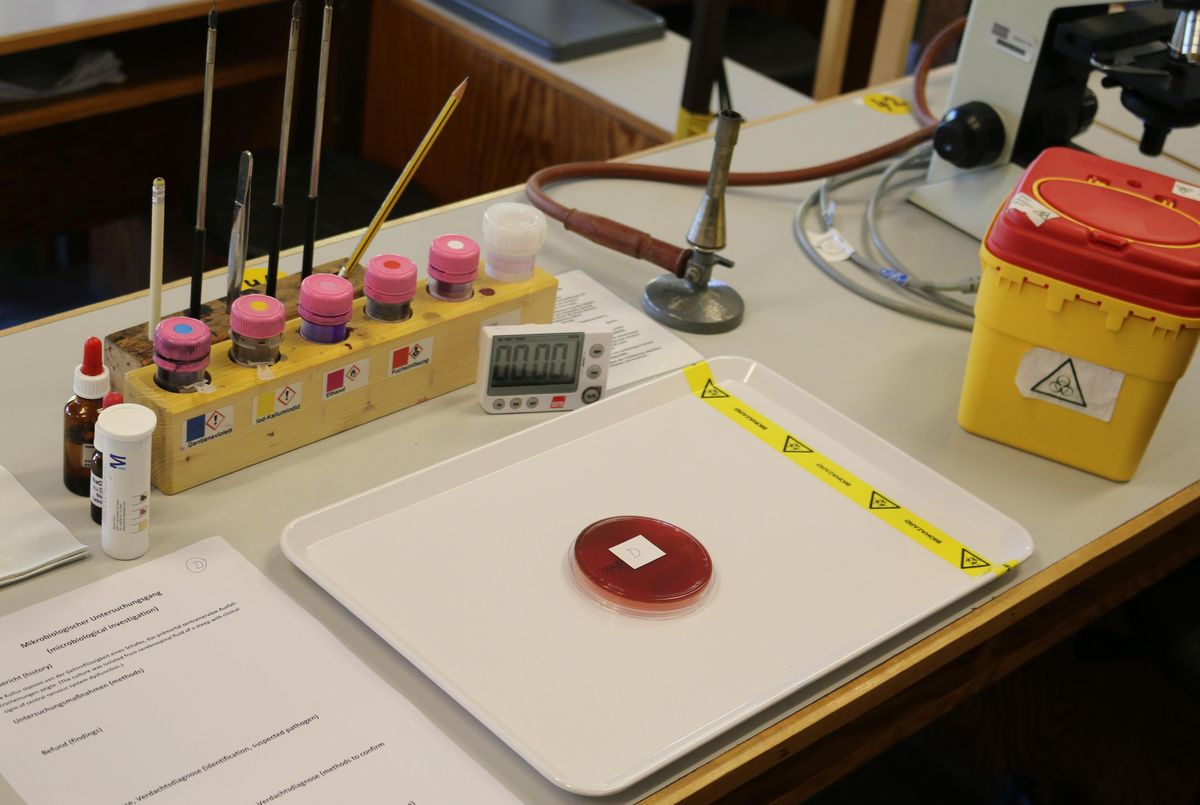The course "Specific Bacteriology and Mycology and Animal Diseases" takes place in the 5th semester and offers a comprehensive overview of bacteriological and mycological pathogens of importance in veterinary medicine. In the microbiological course you will learn individual examination techniques to detect important pathogens.
Topics of Lectures and Exercises
In the current lecture and course programme you can get an overview of the pathogens covered. Before each course there is an obligatory instruction on occupational health and safety.
- Occupational health and safety regulations, microscopic examination of a native preparation, fractionated smear
- Gram-positive cocci: staphylococci and streptococci
- Gram positive bacilli Listeria, Erysipelothrix, Trueperella, Corynebacterium, Bacillus
- Acid-resistant and partially acid-resistant rods: Mycobacteria, Nokardien, Rhodococcus
- Gram-negative rods I: Enterobacteriaceae (Salmonella enterica, Escherichia coli, Klebsiella), Bordetella bronchiseptica
- Gram-negative rods II: Pasteurellaceae, Pseudomonas aeruginosa
- Anaerobes: Clostridium, Brachyspiren, Fusobacterium and other Gram-negative Anaerobes
- Mushrooms and Yeasts
Learning Objectives
Learning objectives provide orientation on the structure and teaching content of the lecture and exercise. Furthermore, they should support you in goal-oriented learning.
You can...
- name and write down pathogens of specific bacterial and mycological diseases taxonomically correct.
- name the host spectrum and the possible clinical and pathological manifestations of an infection or intoxication for a pathogen.
- designate general and veterinary characteristics of a pathogen.
- designate sample material suitable for a pathogen or for a specific infectious disease or intoxication and explain the diagnostic measures to be taken.
-
designate the animal health status of an infectious disease.
-
explain general principles of immunoprophylaxis and transfer them to specific examples.
-
explain prophylactic measures for a specific infectious disease.
-
define infection, intoxication and toxicoinfection and name examples.
-
explain the etiology of infectious factor diseases.
-
explain habitat and meaning of fungi.
-
name fungal groups.
-
explain predisposing factors for fungal infections.
-
give examples of mycotoxins and explain their effects.
In the microbiological course you will internalise the course of a bacteriological and mycological examination. You will get to know individual examination techniques for the detection of important pathogens. During the course we will offer you the opportunity to acquire the following skills:
- You are able to work safely with bacterial infectious agents within the framework of the Infection Protection Act and the Ordinance on Biological Substances. By implementing the occupational health and safety regulations, you prevent infection and the spread of the pathogens.
- You can use a light microscope and are able to estimate the size of microorganisms.
- You recognise connections between a preliminary report and the examination measures to be initiated and take this knowledge into account in the bacteriological and mycological examination procedure.
- You know the importance of staining for the differentiation of bacterial pathogens, you can recognize the staining and make corresponding findings and diagnoses. You are able to prepare a culture smear. You can stain a smear according to Gram using the protocol provided.
- You know how to use your sense of sight and smell for the detection of diagnostic findings.
- You can recognize and evaluate a direct smear coloured by Gram-, Ziehl-Neelsen-, Foth-, Stanford- or Giménez.
- You know important culture media and their diagnostic significance. You can interpret the changes on some important differential culture media.
- You know how to isolate pathogens from mixed cultures. You are familiar with the use of individual selective enrichment media. You can execute the fractionated smear.
- You can make and evaluate a stained adhesive tape preparation of a fungus culture.
- You can describe a culture macroscopically.
- You are able to identify important, light microscopically recognizable structures of the fungi species Trichophyton, Microsporum, Aspergillus and Penicillium.
- You carry out an appropriate bacteriological and mycological examination with a strict separation of findings, diagnosis and suspected diagnosis.
- You have extensive knowledge of the techniques used to clarify your suspected diagnoses.
- You are able to make a number of bacteriological and mycological diagnoses. You have collected the findings for these diagnoses as part of examination measures that you have initiated and performed yourself.
-
In your veterinary studies, you have acquired knowledge of the clinic, pathology and epidemiology of bacteriological infectious diseases in various courses. During the course you will take advantage of this opportunity and use this knowledge to formulate your suspected diagnosis, which must be consistent with both your bacteriological diagnosis and the preliminary report. You will also learn to use your knowledge in the etiological interpretation of your bacteriological and mycological results.
You should be familiar with individual biochemical key reactions for the differentiation of bacterial pathogens. However, it is not advisable to memorize the results of entire biochemical test series ("coloured series") for the different pathogens. Furthermore, it is unnecessary to be able to reproduce the staining protocols. However, the staining principle should be clear to you.
The best way to achieve our learning objectives is to carry out the bacteriological or mycological examination in a concentrated and independent manner after theoretical preparation. You will document your examination measures, the findings, the diagnosis, the suspected diagnosis, the further measures to clarify the suspected diagnosis and the etiological interpretation on an examination sheet
. In order to give you enough time for this work, we have greatly shortened the introductions. Therefore, it is important that you enter the course room prepared.
We hope that the course will give you the pleasure of bacteriological and mycological diagnostics. Your natural curiosity, your trained sense of sight and smell as well as your veterinary expertise are good prerequisites for this.
